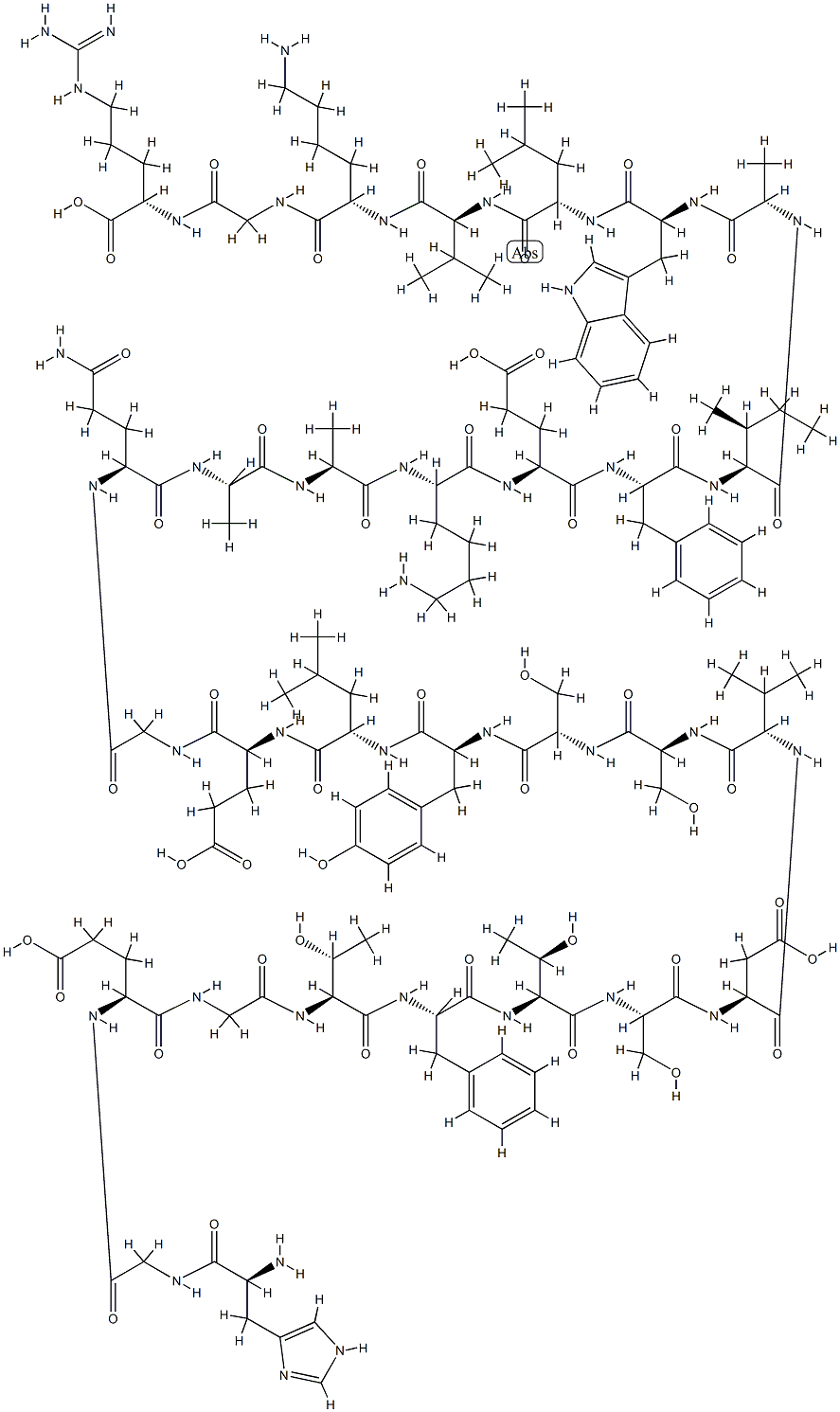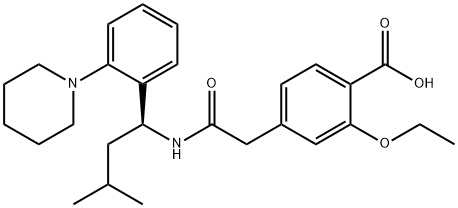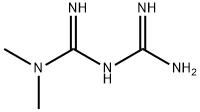Exendin-4
- CAS NO.:141758-74-9
- Empirical Formula: C184H282N50O60S
- Molecular Weight: 4186.57188
- MDL number: MFCD00240171
- EINECS: 686-356-3
- SAFETY DATA SHEET (SDS)
- Update Date: 2024-11-19 20:33:22

What is Exendin-4?
Description
Exenatide is the first drug in a new class of anti-diabetics known as the incretin mimetics, and it is indicated as adjunctive therapy to improve glycemic control in patients with type 2 diabetes who are taking metformin, a sulfonylurea, or both, but have not achieved adequate glycemic control. Exenatide is a functional analog of the human incretin Glucagon-Like Peptide-1 (GLP-1). GLP-1 is naturally released from cells in the GI tract in response to food intake and acts on its receptor on b-cells to potentiate glucose-stimulated insulin secretion. Exenatide is a long-acting agonist at the GLP-1 receptor. It is a synthetic version of a 39-amino acid peptide found in the salivary secretions of the Gila monster lizard.also moderates peak serum glucagon levels during hyperglycemic periods following meals, but does not interfere with glucagon release in response to hypoglycemia. The dosing regimen for exenatide is 5 or 10 mg twice daily, administered as a subcutaneous injection within an hour before morning and evening meals. Following subcutaneous administration, peak plasma concentrations of exenatide are reached in 2.1 h, and the plasma pharmacokinetic profile is dose proportional. The most common adverse events reported with exenatide include nausea, vomiting, diarrhea, feeling jittery, dizziness, headache, and dyspepsia.
Description
Exendin-4 is a 39 amino acid polypeptide and incretin mimetic involved in the glucose-dependent enhancement of insulin secretion. It was first isolated from Gila monster saliva. It also promotes the reduction of hyperglycemia, glucose-dependent suppression of inappropriately high glucagon secretion, slowing of gastric emptying, and reduction of food intake, often with body weight reduction or blunting of weight gain. The synthetic form, Exenatide, is a glucagon-like peptide-1 (GLP-1) agonist approved for the treatment of diabetes mellitus type II, has a long half-life.
Originator
Amylin (US)
The Uses of Exendin-4
Antidiabetic.
The Uses of Exendin-4
Exendin-4 has been used as incretin mimetics for the treatment in HepG2 cells to exclude the influence of auxiliary material. It has also been used as an r (GLP-1R) agonist to exclude interference from auxiliary material.
What are the applications of Application
Exendin-4 is a 39 amino acid polypeptide, incretin mimetic, GLP-1R agonist, and insulinotropic agent.
Definition
ChEBI: A bioactive polypeptide of 39 amino acid residues isolated from the saliva of the Gila monster (Heloderma suspectum). High-affinity glucagon-like peptide 1 (GLP-1) receptor agonist (Kd = 136 pM); potently indu es cAMP formation without stimulating amylase release in pancreatic acini; potentiates glucose-induced insulin secretion in isolated rat islets; protects against glutamate-induced neurotoxicity. A synthetic version is called exenatide.
brand name
Byetta
General Description
Exendin-4 is an incretin mimetic peptide, which is composed of 39 amino acids. It is an analog of glucagon-like peptide 1 (GLP-1), and an insulinotropic agent, with a long half-life. Exendin-4 was historically isolated from the venom of Gila monster lizard called Heloderma suspectum.
Biochem/physiol Actions
Activates GLP-1 (glucagon-like peptide-1) receptors to increase intracellular cAMP in pancreatic acinar cells; has no effect on VIP receptors.
in vitro
exendin-4 showed a pronounced effect on intracellular camp generation. treatment of glp-1 in combination with exendin-4 showed additive action on the generation of camp. in isolated rat islets and in mouse insulinoma beta tc-1 cells, exendin-4 stimulated the glucose-induced insulin secretion in a dose dependent manner [2]. in basal forebrain cholinergic neurons, exendin-4 greatly reduced ibotenic acid-induced depletion of choline acetyltransferase immunoreactivity [3].
in vivo
in ob/ob mice, administration of exendin-4 (10 μg/kg or 20 μg/kg) improved insulin sensitivity and significantly reduced serum glucose and hepatic steatosis. exendin-4 appeared to effectively reverse hepatic steatosis in ob/ob mice by improving insulin sensitivity [1]. in athymic mice, 63% of exendin-4-treated mice achieved graft function compared with 21% of untreated mice (p = 0.033) in the short-term study. 88% of treated mice had functioning grafts compared with 22% of controls (p = 0.015) in the long-term study. exendin-4-treated mice gained significantly more weight than the untreated counterparts [4].
storage
-20°C (desiccate)
References
[1]ding x, saxena n k, lin s, et al. exendin‐4, a glucagon‐like protein‐1 (glp‐1) receptor agonist, reverses hepatic steatosis in ob/ob mice[j]. hepatology, 2006, 43(1): 173-181.
[2]gke r, fehmann h c, linn t, et al. exendin-4 is a high potency agonist and truncated exendin-(9-39)-amide an antagonist at the glucagon-like peptide 1-(7-36)-amide receptor of insulin-secreting beta-cells[j]. journal of biological chemistry, 1993, 268(26): 19650-19655.
[3]perry t a, haughey n j, mattson m p, et al. protection and reversal of excitotoxic neuronal damage by glucagon-like peptide-1 and exendin-4[j]. journal of pharmacology and experimental therapeutics, 2002, 302(3): 881-888.sharma a, srenby a, wernerson a, et al. exendin-4 treatment improves metabolic control after rat islet transplantation to athymic mice with streptozotocin-induced diabetes[j]. diabetologia, 2006, 49(6): 1247-1253.
Properties of Exendin-4
| RTECS | VT9545000 |
| storage temp. | −20°C |
| solubility | ≥145 mg/mL in DMSO; insoluble in EtOH; ≥52 mg/mL in H2O with gentle warming |
| form | White to off-white solid. |
| color | White to off-white |
| Water Solubility | Soluble in water (1 mg/ml) |
Safety information for Exendin-4
Computed Descriptors for Exendin-4
| InChIKey | HTQBXNHDCUEHJF-AAPNSGCPNA-N |
New Products
Tert-butyl bis(2-chloroethyl)carbamate (S)-3-Aminobutanenitrile hydrochloride N-Boc-D-alaninol N-BOC-D/L-ALANINOL N-octanoyl benzotriazole 4-Hydrazinobenzoic acid 3,4-Dibenzyloxybenzaldehyde 1,1’-CARBONYLDIIMIDAZOLE R-2-BENZYLOXY PROPIONIC ACID 1,1’-CARBONYLDI (1,2-4 TRIAZOLE) 4-HYDROXY BENZYL ALCOHOL 3-NITRO-2-METHYL ANILINE (2-Hydroxyphenyl)acetonitrile 4-Bromopyrazole 5-BROMO-2CYANO PYRIDINE 5,6-Dimethoxyindanone 5-broMo-2-chloro-N-cyclopentylpyriMidin-4-aMine 4-methoxy-3,5-dinitropyridine 2-(Cyanocyclohexyl)acetic acid 2-aminopropyl benzoate hydrochloride 1-(4-(aminomethyl)benzyl)urea hydrochloride tert-butyl 4- (ureidomethyl)benzylcarbamate diethyl 2-(2-((tertbutoxycarbonyl)amino) ethyl)malonate Ethyl-2-chloro((4-methoxyphenyl)hydrazono)acetateRelated products of tetrahydrofuran
You may like
-
 Exenatide CAS 141758-74-9View Details
Exenatide CAS 141758-74-9View Details
141758-74-9 -
 55441-95-7 99%View Details
55441-95-7 99%View Details
55441-95-7 -
 N-Vinylformamide 99%View Details
N-Vinylformamide 99%View Details
13162-05-5 -
 Chloro Uracil 1820-81-1 99%View Details
Chloro Uracil 1820-81-1 99%View Details
1820-81-1 -
 207557-35-5 99%View Details
207557-35-5 99%View Details
207557-35-5 -
 2-ethyl-6-methyl-3-hydroxypyridine succinate 99%View Details
2-ethyl-6-methyl-3-hydroxypyridine succinate 99%View Details
127464-43-1 -
 2-ETHYLPYRIDINE 100-71-0 99%View Details
2-ETHYLPYRIDINE 100-71-0 99%View Details
100-71-0 -
 181228-33-1 (S)-Methyl 3-amino-2-((tert-butoxycarbonyl)amino)propanote Hydrochloride (DAP-OMe. HCl) 99%View Details
181228-33-1 (S)-Methyl 3-amino-2-((tert-butoxycarbonyl)amino)propanote Hydrochloride (DAP-OMe. HCl) 99%View Details
181228-33-1







